Control over powder flow can be a sticky issue for tablet manufacture. Tim Freeman, Freeman Technology, and Debbie Huck, Malvern Instruments, look at new research into the relationship between particle morphology and powder flow that can aid tablet process engineering.
The ease with which powders flow is an issue of practical importance in pharmaceutical processing. Flow behaviour can have a significant impact on manufacturing efficiency – the speed at which a tablet press can be run for example – and can also directly affect product quality variables such as dose uniformity.
Effective control of flowability relies on understanding the factors that define it, but this is a complex area. Current knowledge is limited in many instances to general statements of relationship rather than quantified correlation, even for parameters such as size and shape that are easy to identify as being important.
Advances in powder testing, along with other key material characterisation techniques such as particle shape analysis, present an opportunity to change this situation. For instance, it is now possible to measure reliably the flow properties of a powder and relate these directly to particle morphology (size and shape). Such investigations lead to a better understanding of how particle morphology affects bulk powder behaviour under different conditions and, more importantly, how particle properties can be modified to control powder behaviour.
This paper presents new research that helps quantify the relationships between particle size and shape, and powder properties, for different types of lactose, an excipient widely used in pharmaceutical manufacture. Experiments were carried out using the technique of automated imaging for particle size and shape characterisation. Dynamic, shear and bulk powder testing methodologies were used to investigate powder behaviour.
measuring powders
The effect of particle shape on powder flow properties is widely recognised but not yet comprehensively understood. Very few studies provide quantitative data about the effect of particle morphology on flow. This is in a large part attributable to a lack of suitable instrumentation, although the difficulty of selecting an appropriate range of samples is also a complicating factor. Detailed investigation into the effect of particle shape, for example, relies on identifying samples that differ only in this regard.
Reliable particle size data have long been accessible via laser diffraction analysis, but statistically relevant shape measurements have not been so easy to come by. Microscopy is the traditional technique for analysing shape but it can be both time-consuming and subjective. Historically, reproducible powder testing has also been challenging, despite the many different methods developed. Now, however, there are new techniques that can be applied – methods that enable more systematic, scientific study in both of these important areas.
Automated image analysis has transformed the efficiency of particle shape analysis, accelerating measurement and delivering greater statistical relevance
Automated image analysis has transformed the efficiency of particle shape analysis, accelerating measurement and delivering greater statistical relevance. Building on advances in both camera technology and computing power, these powerful characterisation systems generate highly accurate particle size and shape descriptors from microscope quality images of hundreds of thousands of particles. Measurements are complete in just a few minutes.
On the powder testing front, the introduction of dynamic techniques has brought notable improvements in the area of flow characterisation. In dynamic testing, a powder is measured while in motion. The axial and rotational forces acting on a helical blade as it moves through a sample are measured precisely to generate values of flow energy, a parameter that directly quantifies resistance to flow.
Well-defined methodologies and automation give dynamic testing the very highest levels of reproducibility. By combining dynamic testing with other methodologies, such as shear and bulk property measurement, modern testers provide secure multi-faceted characterisation for the extensive investigation of powder behaviour.
lactose study
Investigating the behaviour of different lactose samples
In a recent study,2 three chemically identical lactose powders were comprehensively characterised. Automated imaging was applied (Morphologi G3, Malvern Instruments) to generate particle size and shape data for each sample and a range of powder properties was measured using the FT4 Powder Rheometer (Freeman Technology). These included: flow energy, shear properties, bulk density, compressibility and permeability. Full details of the test methodologies are described in reference 1.
Particle size and shape: To measure particle size and shape, the powders being examined were dispersed onto a sample plate using the dispersion unit integral to the image analysis system, and were then analysed according to standard operating procedures. Figure 1 shows examples of the captured images, and the size and shape parameters for the samples are summarised in Table 1.
| Table 1: Summary of particle size and shape characteristics | ||||
| (a) FlowLac 100 | (b) InhaLac 230 | (c) SpherolLac 100 | ||
| D[v,0.1] | 61.9 | 47.6 | 77.1 | |
| CED (µm) | D[v,0.5] | 140.2 | 94.6 | 151.7 |
| D[v,0.9] | 221.6 | 120.3 | 238.2 | |
| D[n,0.1] | 0.77 | 0.69 | 0.68 | |
| HSC | D[n,0.5] | 0.91 | 0.82 | 0.83 |
| D[n,0.9] | 0.96 | 0.91 | 0.91 | |
Automated imaging systems capture 2D images of the particles in a sample and typically report size in the form of a parameter such as Circular Equivalent Diameter (CED). This is the diameter of a circle with the same area as the projected area of the particle image. The data shown indicate that the FlowLac 100 (FL) and the SpheroLac 100 (SL) samples have closely similar size distributions but that InhaLac 230 (IL) is markedly finer. Size distributions for the samples (not shown) indicate that the InhaLac is also more monodisperse.
The shape parameter reported here is High Sensitivity Circularity (HSC), a normalised value that describes how close the particles are to being circular. It is calculated according to the following equation:
HS Circularity = 4 x p x area / perimeter2
A value of 1 indicates a highly circular shape while a figure close to 0 indicates much greater irregularity. Here, the SL and IL are closely similar but the FL has a more regular, circular shape. Distributions of shape are reported in exactly the same way as for size distributions.
The samples chosen displayed variations in particle size and particle shape that are the result of their method of manufacture, and were specifically selected to enable distinction between the effects of size and of shape. Two of the samples are comprised of similarly shaped but differently sized particles, while the third sample is more circular than the other two but of similar size to one of them.
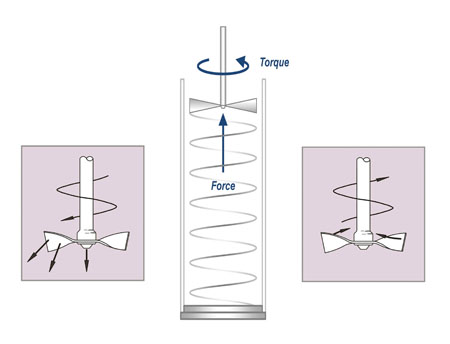
Figure 2: During BFE testing the blade is rotated down through the sample, pushing the powder against the vessel base (left hand image), while for SE testing the blade is rotated in the opposite direction, upwards through the sample, exerting a gentler, lifting action (right hand image)
Flow energy: Two sets of dynamic flow energy data were generated for the three samples. Basic Flowability Energy (BFE) is measured using a downward bulldozing blade action and tends to be indicative of flow behaviour under moderate to high stress or confined conditions (Figure 2). The results (Figure 3a) show repeated tests and the impact of changing the blade’s tip speed.
Specific Energy (SE), in contrast to BFE, is measured by rotating the blade upwards through the sample in a way that gently displaces the powder bed. It provides a good measure of the relative mechanical locking and particle friction under low stress conditions (Figure 3b).
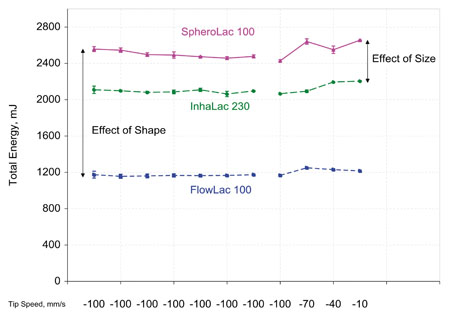
Figure 3a
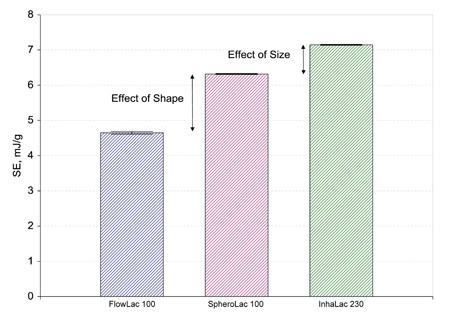
Figure. 3a and 3b: Comparing data for BFE (Fig. 3a) and for SE (Fig. 3b) for three lactose samples shows that shape has a more marked impact on flowability than size for these materials
Both sets of data suggest that the shape of particles in these samples is more important than their size in determining powder flow behaviour.
Comparing data for FL and SL indicates that more uniformly shaped particles flow more easily when other factors, such as particle size, are equal. Both SE and BFE are higher for the less regular material, with the change in BFE especially marked. Looking at data for SL and IL, materials with closely similar shape profiles, it is clear that while size does influence flowability it has a much less pronounced impact than shape.
Compressibility and permeability: The permeability of a powder bed is assessed by measuring the resistance it presents to the flow of air, i.e. the pressure drop across the bed at a known flow rate. Compressibility, on the other hand, is a measurement of how the density of the bed changes when subjected to a compressing force. Both parameters tend to be dominated by particle packing behaviour within the powder bed.
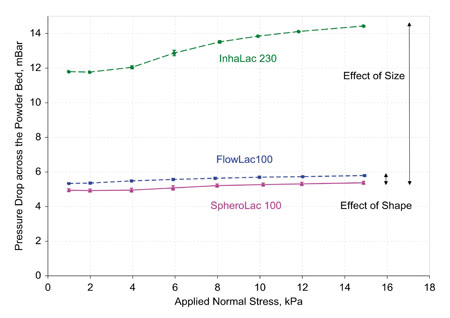
Figure 4: Permeability tests for three different types of lactose powder indicate that particle size is the dominant factor in determining this aspect of behaviour
The results (see Figures 4 and 5) show that for these parameters the effects of particle size are more influential than particle shape, a trend directly attributable to the packing structure that develops in the stationary powder. The relatively large size and irregular shape of the SL, for example, make it most likely to pack with significant voids (spaces). Permeability in the bed is high because air can easily flow upwards with little resistance. However, the same irregularity in large particle size means that the mechanical interlocking of contacting particles is substantial, and the compression forces applied do little to move adjacent particles relative to one another, giving rise to low compressibility.
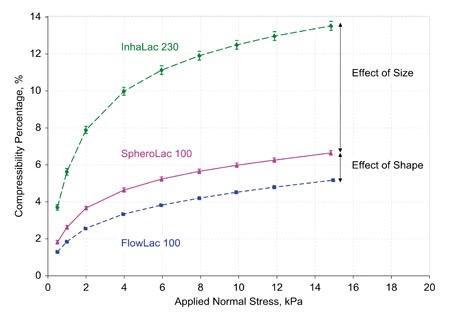
Figure 5: Compressibility tests for three different types of lactose powder show that here particle size is the dominant factor in determining behaviour
In contrast, IL, which is a finer more cohesive powder, will have a tendency to trap air within its structure, making it highly compressible. However, such beds tend to have low permeability, even though bulk air content is high, because channels within them are small and poorly interconnected.
Shear tests: In shear testing the powder is analysed under an applied pressure giving insight into behaviour under relatively high stress conditions. One consolidated powder face is sheared relative to another to assess shear strength in the powder bed, and the resulting data are frequently used in the design of hoppers. The shear results for the lactose samples indicate that particle shape is once more the dominant factor (Figure 6), with the increased frictional surface of the less spherical materials increasing resistance to flow. The effect observed is not, however, as marked as in the low stress tests (flow energy), highlighting the greater sensitivity of dynamic testing to changes in behaviour.
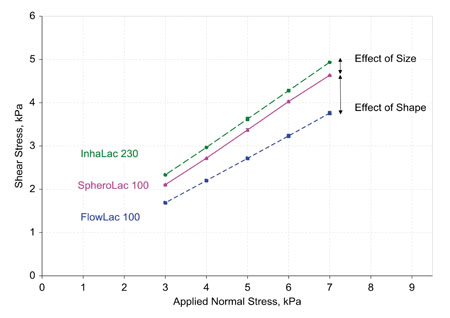
Figure 6: Shear testing indicates that shape has a larger influence than size on the resistance of the powder to flow
To conclude, the industry’s current drive for greater manufacturing efficiency increases the need to understand and control the factors that support successful processing. The issue of powder flow is an important one because of its potential impact on plant efficiency and on product quality attributes such as content uniformity. The data presented here show how advances in instrumentation mean that there is now a solid platform on which to base exploration of some of the factors affecting powder flow, such as particle morphology, in order to understand and control it.
In this study accurate, statistically relevant particle size and shape data were generated using the technique of automated imaging. These have been used to investigate the impact of particle morphology on dynamic, shear and bulk powder properties. The result is correlations between distinct aspects of powder behaviour and variables such as particle size and shape that can be readily manipulated to target specific performance. For these lactose samples flow behaviour is shape dominated, while static bulk properties such as permeability and compressibility are more sensitive to changes in particle size.
The most important feature of the study, however, is that it shows how, using state-of-the-art instrumentation, powder manufacturers can access the information required to adopt a knowledge-led approach to powder property control, and to engineer the behaviour required to improve process efficiency and achieve consistent, high quality final product. mc
References
1. R E Freeman, Powder Technology, 174, 1-2, 25-33 (2007).
2. X Fu and D Huck et al. Particuology, 10 (Issue 2) 203-208 (2012)




